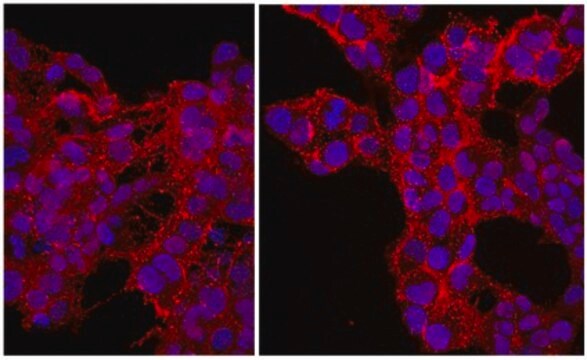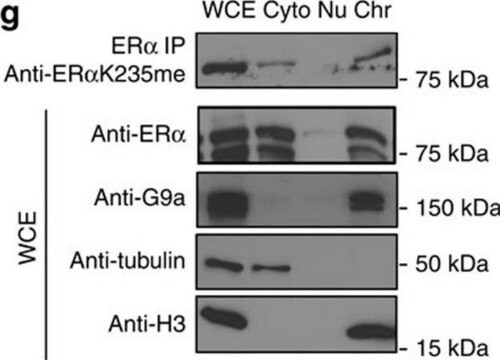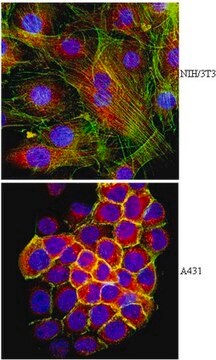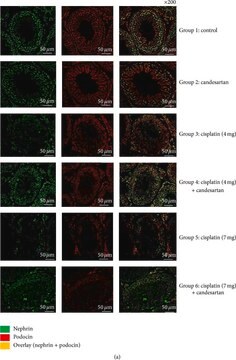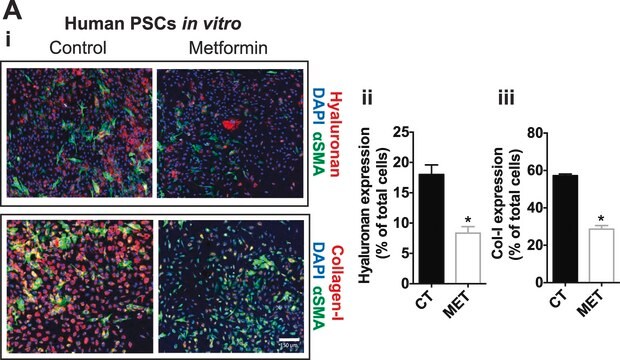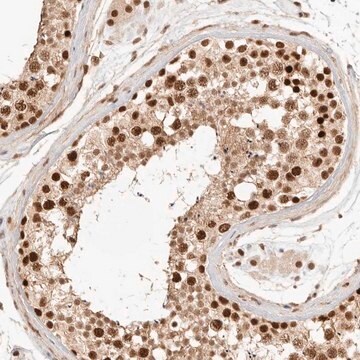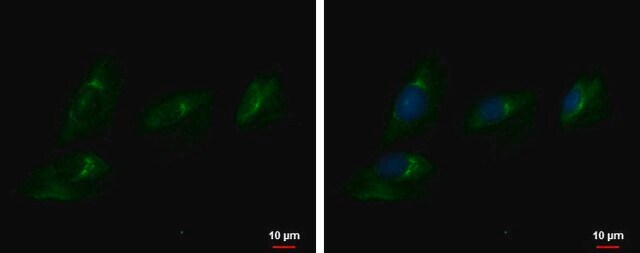推荐产品
生物源
rabbit
共軛
unconjugated
抗體表格
affinity isolated antibody
抗體產品種類
primary antibodies
無性繁殖
polyclonal
產品線
Prestige Antibodies® Powered by Atlas Antibodies
形狀
buffered aqueous glycerol solution
物種活性
human, mouse, rat
技術
immunoblotting: 1:100-1:250
immunohistochemistry: 1:200-1:500
免疫原序列
AGGQHLLGPPDGAKALEVAAPESQGLDSSLDGAARPKGSRRSVPRSSGQTVCRCPNCLEAERLGAPCGPDGGKKKHLH
UniProt登錄號
運輸包裝
wet ice
儲存溫度
−20°C
目標翻譯後修改
unmodified
基因資訊
human ... SP6(80320)
一般說明
SP6 (sp6 transcription factor), also called as KLF14 (kruppel-like factor 14) or Epfn (epiprofin) belongs to SP/KLF (kruppel-like factor) transcription factor family. The protein is encoded by maternally inherited intronless gene, mapped to human chromosome 17q21.3-q22.
KLF14 transcription factor is predominantly expressed in fetal tissues and placenta than in adult tissues. The encoded protein consists of three C2H2-type zinc-fingers attached to each other by kruppel-links at the end of the carboxy-terminal domain and transactivation/suppressor domain at the end of the N-terminal domain.
KLF14 transcription factor is predominantly expressed in fetal tissues and placenta than in adult tissues. The encoded protein consists of three C2H2-type zinc-fingers attached to each other by kruppel-links at the end of the carboxy-terminal domain and transactivation/suppressor domain at the end of the N-terminal domain.
免疫原
Sp6 transcription factor recombinant protein epitope signature tag (PrEST)
應用
All Prestige Antibodies Powered by Atlas Antibodies are developed and validated by the Human Protein Atlas (HPA) project and as a result, are supported by the most extensive characterization in the industry.
The Human Protein Atlas project can be subdivided into three efforts: Human Tissue Atlas, Cancer Atlas, and Human Cell Atlas. The antibodies that have been generated in support of the Tissue and Cancer Atlas projects have been tested by immunohistochemistry against hundreds of normal and disease tissues and through the recent efforts of the Human Cell Atlas project, many have been characterized by immunofluorescence to map the human proteome not only at the tissue level but now at the subcellular level. These images and the collection of this vast data set can be viewed on the Human Protein Atlas (HPA) site by clicking on the Image Gallery link. We also provide Prestige Antibodies® protocols and other useful information.
The Human Protein Atlas project can be subdivided into three efforts: Human Tissue Atlas, Cancer Atlas, and Human Cell Atlas. The antibodies that have been generated in support of the Tissue and Cancer Atlas projects have been tested by immunohistochemistry against hundreds of normal and disease tissues and through the recent efforts of the Human Cell Atlas project, many have been characterized by immunofluorescence to map the human proteome not only at the tissue level but now at the subcellular level. These images and the collection of this vast data set can be viewed on the Human Protein Atlas (HPA) site by clicking on the Image Gallery link. We also provide Prestige Antibodies® protocols and other useful information.
生化/生理作用
SP6 (sp6 transcription factor) might be involved in regulation of transcription process. In mice, SP6 or Epfn (Epiprofin) is involved in epidermal development.
TGF (transforming growth factor)-β treatment upregulates SP6 or KLF14 (Kruppel-like factor 14), which is a vital non-smad protein that potentially represses the transforming growth factor-β receptor II (TGF-βRII). SP6 aids in tooth development by regulating the epithelial cell fate and tooth number.
TGF (transforming growth factor)-β treatment upregulates SP6 or KLF14 (Kruppel-like factor 14), which is a vital non-smad protein that potentially represses the transforming growth factor-β receptor II (TGF-βRII). SP6 aids in tooth development by regulating the epithelial cell fate and tooth number.
特點和優勢
Prestige Antibodies® are highly characterized and extensively validated antibodies with the added benefit of all available characterization data for each target being accessible via the Human Protein Atlas portal linked just below the product name at the top of this page. The uniqueness and low cross-reactivity of the Prestige Antibodies® to other proteins are due to a thorough selection of antigen regions, affinity purification, and stringent selection. Prestige antigen controls are available for every corresponding Prestige Antibody and can be found in the linkage section.
Every Prestige Antibody is tested in the following ways:
Every Prestige Antibody is tested in the following ways:
- IHC tissue array of 44 normal human tissues and 20 of the most common cancer type tissues.
- Protein array of 364 human recombinant protein fragments.
聯結
Corresponding Antigen APREST75965
外觀
Solution in phosphate buffered saline, pH 7.2, containing 40% glycerol and 0.02% sodium azide.
法律資訊
Prestige Antibodies is a registered trademark of Merck KGaA, Darmstadt, Germany
免責聲明
Unless otherwise stated in our catalog or other company documentation accompanying the product(s), our products are intended for research use only and are not to be used for any other purpose, which includes but is not limited to, unauthorized commercial uses, in vitro diagnostic uses, ex vivo or in vivo therapeutic uses or any type of consumption or application to humans or animals.
未找到合适的产品?
试试我们的产品选型工具.
儲存類別代碼
10 - Combustible liquids
水污染物質分類(WGK)
WGK 1
閃點(°F)
Not applicable
閃點(°C)
Not applicable
S Scohy et al.
Genomics, 70(1), 93-101 (2000-11-23)
Using the sequence of the SP1 zinc-finger DNA-binding domain as a probe to screen a mouse EST database, we identified two novel members of the SP/XKLF transcription factor family, KLF13 and KLF14. The mouse Klf13 cDNA (1310 bp in length)
Takashi Nakamura et al.
The Journal of biological chemistry, 283(8), 4825-4833 (2007-12-25)
In tooth morphogenesis, the dental epithelium and mesenchyme interact reciprocally for growth and differentiation to form the proper number and shapes of teeth. We previously identified epiprofin (Epfn), a gene preferentially expressed in dental epithelia, differentiated ameloblasts, and certain ectodermal
C R Gonzalez et al.
Cytokine, 61(2), 670-675 (2013-01-16)
Transforming growth factor β1 (TGF-β1) is a pleiotropic cytokine that modulates cell homeostasis. In Leydig cells, TGF-β1 exerts stimulatory and inhibitory effect depending on the type I receptor involved in the signaling pathway. The aim of the present work was
Layla Parker-Katiraee et al.
PLoS genetics, 3(5), e65-e65 (2007-05-08)
Imprinted genes are expressed in a parent-of-origin manner and are located in clusters throughout the genome. Aberrations in the expression of imprinted genes on human Chromosome 7 have been suggested to play a role in the etiologies of Russell-Silver Syndrome
Takashi Nakamura et al.
Journal of cell science, 127(Pt 24), 5261-5272 (2014-10-26)
The basal layer of the epidermis contains stem cells and transit amplifying cells that rapidly proliferate and differentiate further into the upper layers of the epidermis. A number of molecules have been identified as regulators of this process, including p63
我们的科学家团队拥有各种研究领域经验,包括生命科学、材料科学、化学合成、色谱、分析及许多其他领域.
联系技术服务部门
